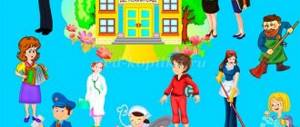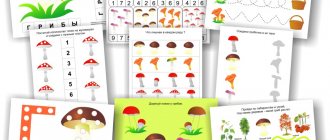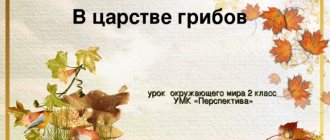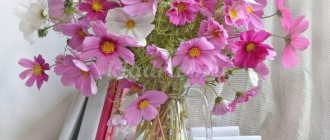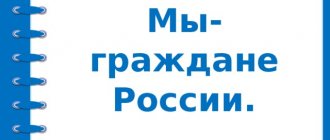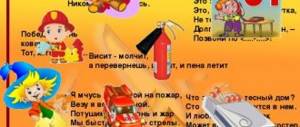Presentation “Such different birds” for preschool educational institutions
Contents
Dear colleagues! I bring to your attention an educational presentation with interactive tasks for children of primary and secondary preschool age, which I developed when planning the thematic week “Birds are our friends.” The presentation “Such different birds” can be used in an ecology lesson, in joint and subgroup work with children.
Educational presentation “Such different birds” for preschool children
Presentation Objectives
- Educational:
- Developmental: develop observation, visual perception and other mental processes, the ability to draw conclusions.
- Educational: to instill in children a caring attitude towards birds.
1. Expand children's knowledge about birds, the ability to distinguish them, group them, describe the appearance of birds, their features, behavior;
2. Encourage children to engage in verbal interaction with peers and the teacher;
3. Strengthen the skill of using complex sentences with the preposition “because”, intensify the use of adjectives and verbs in speech.
- Motivation: the recording of “Bird Voices” is playing. Guys, I think I hear beautiful sounds, listen. Who is this? These are birds. There are different types of birds, which ones do you know? Children's answers. Do you want to know more about bird life?
- Discovery of new knowledge: Sit down on the carpet, I will tell you some bird secrets.
Progress of the presentation
Slide 2.
Spring is the time of year when all nature wakes up from sleep, plants come to life and bird commotion begins. Here and there all the birds are working hard, chirping and jumping. How nice it is to look at them! Let's learn more about birds. They are all similar to each other and thus differ from animals and fish.
Slide 3.
How are all the birds similar to each other? (examination of the main parts of the bird’s body).
Slide 4.
Interactive task. Bird feathers are very beautiful and different. Look how many feathers there are here, each has a pair, but one doesn’t. Which one?
Slide 5.
There are birds that live next to us all year round and in the cold winter delight us with their plumage. These birds are winter birds. You've probably seen a titmouse, a crow and a dove.
Slide 6.
And there are birds that fly to warm countries in winter, and return back with the arrival of spring. These are migratory birds that sing beautiful songs to us. These include swallows, swans, and starlings.
Slide 7.
Finger gymnastics “Birds”.
- With the onset of spring, the birds arrive. (Fingers are spread out, palms are crossed. Thumbs are connected, the rest are waved like wings)
- Starlings are returning - hard workers and singers. (Fingers clench into fists and unclench)
- And the rooks are by the puddle (Palms are open, cupped together)
- They circle in a noisy flock. (Circular movements with hands)
- The cranes are flying in a hurry, (Fingers are spread out, palms are crossed. Thumbs are joined, the rest are flapped like wings)
- And the robin and thrush started making nests. (Fingers in palm lock open)
p>
Slide 8.
In spring, all birds build nests for themselves. To do this, they collect twigs, fluff, and grass.
Slide 9.
Birds make the nest warm and comfortable so that the eggs can hatch into chicks.
Slide 10.
Interactive task: Treat the bird only to what it eats. Click on the picture with your mouse.
Slide 11.
Remember what all birds have. Think about why a bird needs wings, a tail, feathers, legs, and a beak. Say kindly the names of the parts of the bird: Wing - wings Head - head Tail - ponytail Paw - paw Feather - feather
Name the chicks correctly: The owl has owlets, the cuckoo has cuckoo chicks, the starling has chicks, the jackdaw has chicks, the crow has chicks, the magpie has chicks, the crane has chicks.
Slide 12.
Is it a bird or not? Explain why? This is a cow, it is not a bird because it has no wings, its body is not covered with feathers and there is no beak.
Slide 13.
Is it a bird or not? Explain why? This is a bird. Her body is covered with feathers, there are wings, legs and a beak.
- Kinesiological gymnastics “Owl”.
- Reflection: Ball game “What do I know about birds.”
The presentation “Such different birds” came in handy during the Bird Day at the preschool educational institution, during which events dedicated to birds were held in all groups, KVN and exhibitions of joint creativity were organized.
infodoo.ru
Presentation "Birds"
Shabaikina Zinaida
Presentation "Birds"
There are many "red"
calendar days that are celebrated annually.
Day is one of them . “International
Bird ” is an environmental holiday celebrated annually on April 1.
The proposed presentation is suitable for consolidating knowledge about migratory, wintering and domestic birds , as well as testing children’s knowledge about various birds . The presentation contains 20 slides .
The presentation is made in the form of illustrations, each of which depicts a bird . Children can figure out who it is from the picture and name the bird . After this, the correct answer comes out (name of the bird )
.
This presentation will help children generalize, compare, and think logically.
1 SLIDE
Presentation title ( “ Birds ”
)
2 SLIDE
– Magpie is one of the most popular birds . from other species of birds of the crow family in its small size, specific black and white coloring and long magpie tail.
3 SLIDE
– The cuckoo lives almost everywhere in Russia. Females usually have red or brown plumage. There are black stripes along the back and head. The feathers themselves are edged with white. And the head and chest are usually light gray in color, but thin black stripes are clearly visible on them. The weight of the female does not exceed one hundred and ten grams. Juveniles are light rufous with dark stripes throughout the body. molt twice a year . In summer this is a partial change of feather, and in winter it is a complete change.
– Males have a dark gray tail and back. The chest and head are grey. All other feathers are quite light with dark stripes. The birds have a dark beak , but their legs are yellow.
4 SLIDE
– The common starling does not grow more than 22 cm with a weight of 75 g and a wingspan of almost 39 cm. It has a massive body resting on reddish-brown legs, a proportionate round head and a short (6-7 cm)
tail.
5 SLIDE
– The crow’s tail is wedge-shaped, with long tail feathers. beak is powerful and sharp , conical in shape, and in some species has a characteristic high bend. The crow's legs are thin and long, with four toes: 1 facing back, 3 facing forward.
– Most species of crows have gray or black plumage that glows metallic, purple, violet or green in the sun. The base of the feather is usually gray, in rare cases white.
6 SLIDE
– bird is a member of the raven family. In its appearance and size it resembles a crow, so some people confuse them. However, the rook has some distinctive features: firstly, it is much slimmer, and secondly, an adult bird has a ring of unfeathered bare skin around its beak. Young individuals do not have such a rim. The rook has black plumage with a metallic sheen. Males are no different in color from females.
7 SLIDE
– An owl is a bird . Depending on where it lives, its plumage may have different colors, camouflaging the owl into the surrounding area. The owl's head is round with large eyes, its talons are long and sharp, and its beak is short and predatory.
8 SLIDE
– The body of pigeons is dense, with a short neck and a small head. The wings are wide and long, the tail is long.
– The beak is usually short, less often of medium length, straight, thin, often with a characteristic widening at the base. The plumage is thick, dense, often gray, brown or cream tones, although brighter colors are also found in the tropics, such as in motley pigeons. The legs are usually short: four-toed, three toes in front and one in back, but well adapted for moving on the ground.
9 SLIDE
– The crane is a tall, stately bird ; the height of representatives of different species ranges from 90 to 175 cm and weighs from 2 to 11 kg. The body of the crane is elongated, teardrop-shaped. When the bird is standing , the long flight feathers of the wing create the impression that it has a long, lush tail, which in some species resembles a train.
– The long neck of the crane is crowned by a small, neat head with an elongated straight beak, 20–30 cm long. Part of the head is devoid of feathers, and the bare area of rough skin is bright red or orange, so from a distance it resembles a cap. The plumage colors of cranes are predominantly grey, white and black.
10 SLIDE
– The tit is the closest relative of the well-known sparrow, it is very similar to it in appearance and habits, from a distance they can even be confused, but only from a distance. Bright yellow abdomen with a black “tie”
, on the head is a black and blue cap, on the neck is also a black scarf, white cheeks, yellow-green back, wings and tail, gray and blue.
11 SLIDE
– All species of nightingales are classified as members of the thrush family. Females and males do not differ from each other in appearance. The common nightingale is a small bird, slightly larger than a sparrow. Its color is also inconspicuous, mostly monochromatic, brown-olive. Part of the bird's abdomen and neck are white. On the sides and chest the color is slightly darker than the main color. The top of the tail has a faint reddish tint. The color of nightingales remains virtually unchanged all year round.
12 SLIDE
– The woodpecker is a small bird , most of them are the size of two palms. The bird's body has an elongated shape. The beak is oblong, sharp and durable. The paws are short - two toes in front and two in back. The wings are small, due to which the woodpecker can move between trees very easily. And also crawl along tree trunks and even hang upside down on tree branches. The woodpecker's head is reliably protected from shocks. birds look very different - one is motley with a red crest, the other is white with gray wings. They are found with striped wings and spotted necks. Some of their feathers have a golden or green tint. As a decoration, their color is a red cap on their head.
13 SLIDE
– The bullfinch is a small bird that looks like a sparrow. Her weight is about 40 grams, although she is of a dense build. The main feature of these birds is their color . Males have a bright red chest, neck and cheeks, and a gray-blue back. The head and beak are black, it may even seem like they are wearing a black cap. The tail and wings are also black, with light stripes on the wings. Bullfinches need a thick, wide beak to get grains and berry seeds. Females have a similar coloration, except for one very important detail - they do not have a red breast, it is colored grayish-brown. Chicks and young birds, before the first molt, are brown in color.
14 SLIDE
– The sparrow is recognizable by its appearance and its characteristic chirping. The color of the plumage in the upper part is brownish-brown interspersed with black feathers. On the head near the ears and belly are light gray. Sparrows have a small short tail and a fairly powerful beak. On average, the body length of a sparrow is about 16 cm, the weight is tiny - from 25 to 35 grams, and the wingspan is up to 27 cm. A male sparrow can be distinguished from a female by a characteristic black spot that covers the chin, throat and upper part of the chest. The male's head is also dark gray in color. The female sparrow is smaller in size, the head and throat are gray, and above the eyes there are gray-yellow stripes, very pale, almost invisible.
15 SLIDE
– In summer you can often see small birds flying tirelessly over vegetable gardens, orchards, and lawns. They have a forked tail and sharp, long wings. These are swallows. They have blue-black backs, wings and tail. The chest and belly of swallows are light gray. If a bird has a noticeable red spot on its forehead, it means it is a chick that has just learned to fly. An adult swallow has a white forehead. There is a small beak on the flattened head. Short legs make it difficult to take off from a smooth surface. Therefore, it is unlikely to catch a bird sitting on the ground. Masterly flight is the purpose of swallows.
16 SLIDE
– Geese’s heads vary in shape. The beak can be straight, curved and concave. In geese of some breeds (Chinese, Kholmogory)
There is a bump above the beak.
The neck of geese comes in different lengths. The chest is round, well developed, fairly wide. The back is wide and of sufficient length. The wings fit tightly to the sides. At the base of the abdomen of some geese, one or two skin folds of various sizes are formed, sometimes hanging down to the ground (Kholmogory geese)
. The length of the legs is not the same in geese of different breeds. The color of the legs varies.
17 SLIDE
– In the formation of a chicken flock, a special role is given to the rooster. The latter always looks spectacular against the backdrop of modest females: colorful plumage, a long flowing tail, pointed feathers in the dorsal and neck area, spurs on the legs. Adult males have a bright crest and dangling earrings located on the sides of the beak and performing the same function with the crest: directing blood flow to the skin and regulating the temperature of the body. The rooster flies rarely and over short distances; in case of danger, it prefers to run quickly. At the end of autumn - beginning of winter, cockerels begin molting, which lasts approximately 6 weeks. It begins to crow at 4 months of age. sleeps on one leg , tucks the other under itself and hides its head under the wing on the side where the leg is tucked.
18 SLIDE
– Chicken is one of the most popular and widespread types of poultry . Belongs to the pheasant family, a genus of combed chickens. The male chicken is called a rooster, the chick is called a chick. Depending on the breed, chickens have different weights, approximately 0.8 - 5 kg, and also differ in feather color, egg color, size and some external features (characteristic of decorative breeds)
. Roosters are usually larger than females, have brighter plumage and a longer tail. With age, spurs form on the rooster's legs - bony outgrowths. Chickens and roosters have a beard and comb, which act as a thermostat and ensure normal blood flow to the skin. The rooster's comb is much larger than that of chickens; in chickens it is hardly noticeable. The shapes of the comb can be leaf-shaped with teeth along the edge, pod-shaped, etc. Despite the fact that chickens have wings, they are incapable of long and high flight.
19 SLIDE
– Domestic ducks are quite large birds with an elongated neck and body, a small head, and short webbed feet. Their four rear tail feathers are curved upward, like those of wild mallard drakes. Males are practically no different from females; a drake can be slightly larger than a duck. The feathers of the thoroughbred varieties are mostly white, but many colored poultry are also found .
20 SLIDE
– This is a slender, long-legged bird with short wings and a tail. Turkeys have a large live weight, strong legs, and powerful wings. The head and upper neck are bare. Legs are red. On her head, on the unfeathered skin, instead of a comb, there are fleshy warty growths ( “corals”
).
There is also a warty nasal process on the forehead. The size of the "corals"
and the nasal process are related to gender. In turkeys they are much smaller than in turkeys, in which, when excited, they become filled with blood and increase several times. The color of the plumage of turkeys depends on the breed they belong to. The live weight of the male is 5 kg, the female is about 3 kg.
Presentation for the project “Who are the birds?”
Presentation for the project “Who are the birds?”
This presentation was prepared for preschool children and can be used in a preschool educational organization. The presentation will also be interesting for younger students. The presented material will introduce children to the world of birds and systematize their knowledge.
View the contents of the document “Presentation for the project “Who are the birds?” »
Who are the birds
All birds have - beak - head - neck - body - legs - 2 wings - tail
Birds' entire body is covered with feathers. No other animals have feathers. Small and fluffy down feathers - for warmth, large ones - for flying, different in color - decorate birds
A bird's nose is not only a nose, but also a mouth, which is why it was called a beak. Only birds have a beak. Birds have different beaks. The largest is that of the pelican, and the smallest is that of the swallow.
Birds that do not fly to warmer climes are called wintering birds. For example: crow, magpie, tit, sparrow, pigeon, woodpecker, crossbill and others
Crossbill hatches chicks in winter, during the very cold season.
The crossbill eats nuts, which is why it has such a special beak.
There are migratory birds: swallows, starlings, orioles, nightingales, swans and others
There are birds that cannot fly: ostriches, kiwis, penguins, cassowaries
Kiwis live in New Zealand in dense, damp forests and are nocturnal. Their wings are almost not developed. And the legs are strong. Kiwis eat worms, which they dig out of the soil with their beaks.
Birds bring many benefits to people and nature. They destroy harmful insects, carry plant seeds, and destroy weak and sick animals. Birds need to be protected and taken care of
kopilkaurokov.ru
